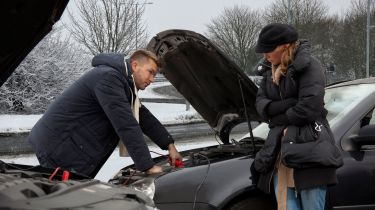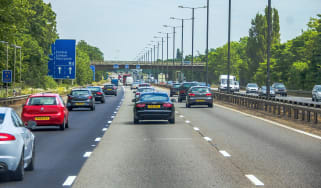How to jump start a car
We cover how to safely jump start and push start a car if your battery goes flat

If you’ve tried to start your car and heard nothing more than a clicking sound from under the bonnet, a flat battery is likely the culprit. Sometimes the engine will struggle to start and the lights will barely work, usually as a result of a battery that’s not quite flat, but too low on charge. It’s a frustrating experience either way, but jump starting your car is a quick way to get back on the move without having to call a recovery vehicle.
Jump starting your car is fairly straightforward once you know how, and our guide will give you the confidence to use it as a way to stop a flat battery from ruining your plans.
What is jump starting?
Your car uses electricity from the battery to start the engine. If your battery is flat, you need to supply the car with a different source of electricity to get the engine turning. Jump starting is a method that uses the electricity from another car’s battery or an external power pack to start a car via a pair of jump leads.
What are jump leads?
Besides another car, a set of jump leads is all the equipment you need to jump start a car. They’re fairly cheap from supermarkets or parts shops, and are essentially a pair of cables with large crocodile clips at each end. The cables are quite thick to handle the high currents that car batteries supply.
The cables and the crocodile-clip handles are covered in plastic or rubber to avoid giving you an electric shock. The only exposed metal you should see are the teeth of the clips that spring shut tightly to ensure a solid grip on the battery terminals.
Jump leads are supplied in pairs. One lead is red with a ‘+’ symbol and should only ever be connected to the positive terminals of the batteries. The black lead has a ‘–’ symbol and should only ever be connected to the negative battery terminal or the earthing point.
How to jump start a car
A set procedure must be followed when jump starting a car to ensure your safety and that no damage is caused to either vehicle. You can easily jump-start a car on your own if you have the keys to both vehicles, while a power pack is your best option if you don’t have access to another car.
Before starting, always check that the jump leads and the batteries of both cars are in good condition. If after a visual inspection you see damage or leaks from a battery, you should call your breakdown provider as it may be unsafe to attempt a jump start.
It’s advisable to tie back long hair and ensure you aren’t wearing any loose clothing or jewellery whenever working near moving parts, including those in the engine bay. When you have done so, follow these steps:
Preparing the cars for jump starting
- Locate the batteries in both cars. While usually found under the bonnet, in some cars it can be found under the rear seats or in the boot. If you’re unsure, check the owner’s manual.
- Position the vehicle with the working battery near enough to the other car so that the jump leads can easily reach between the two batteries.
- With both vehicles fully switched off and the keys out of the ignition, remove or open any covers shielding the battery, including those covering the battery terminals. Do not remove any leads connected to the battery.
- Examine the jump leads to ensure they’re free from damage and check both batteries are in good condition and don’t have any leaks.
Jump starting the car
Now the cars are correctly set up and you have inspected the cables and batteries for damage, you are ready to jump start the car.
- Attach the red lead to the positive terminal on the working battery. This will have a red marker around it, or a ‘+’ symbol.
- Attach the other end of the red lead to the positive terminal on the dead battery.
- Attach the black lead to the negative terminal on the working battery.
- Attach the other end to an ‘earthing point’ on the car with the dead battery. Check your handbook to find a suitable ‘earth’, but if you don’t have one, a solid metal component under the bonnet – such as a bare metal bolt – should be fine. You should ensure your chosen earthing point is away from the battery and fuel system.
- Don’t start the car yet – wait a few moments and let the battery voltages equalise.
- Start the car with the live battery. Let it run for a few minutes before trying to start the car with the dead battery.
- If it doesn’t work, check the connections and try again.
- If it starts, let the engine run for a few minutes while the battery is topped up. Stop it too soon and you’ll probably have to jump-start it again.
Disconnecting the jump leads
Once the engine is running, disconnect the leads in the following order, taking care not to touch the crocodile clips as you do:
- Remove the black negative lead connected to the flat car's earthing point
- Remove the black negative lead connected to the good car
- Remove the red positive lead connected to the flat car
- Remove the red positive lead connected to the good car
How to push start a car
If you don’t have access to jump leads but do have a couple of friends, it’s possible to start a car with a manual gearbox by pushing it along the road – a process sometimes referred to as ’push starting’ or 'bump starting'. In this section we’ll explain how to push or bump start a car.
- Position the car so you have a clear run and check for traffic or other road users.
- Sit in the driver’s seat and, with the clutch pedal fully pressed, select second gear. Keep the clutch pedal fully pressed.
- Turn the ignition key until the green or amber ignition light comes on.
- Check the road is clear, release the handbrake and footbrake and ask your helpers to push the car from behind.
- At around 5mph, release the clutch pedal quickly. The momentum of the car will turn the gearbox, which will then turn the engine.
- If this is successful, the car will start, but you should let the car run for at least 10 minutes to top up the battery. If you stop too soon, you may need to repeat the process.
The information above relates to starting a car with a manual gearbox. Because you can’t manually operate the clutch in an automatic, you can’t push start an automatic car.
How to jump start a car with a portable power pack
Portable power packs can be used to provide energy to a dead battery and can be stored at home. Similar to jump leads, it will have two crocodile clips to connect to your car battery but instead of connecting to another vehicle it is able to provide the power needed to start a car.
This makes it a good solution if you don’t have easy access to a second vehicle. Before attempting to use a power pack, check that it has enough charge. Most will have an indicator to show whether they are ready to use. Keep an eye on the charge level to make sure it is topped up. If a power pack indicator shows below the minimum level needed to work it is unlikely to be able to start your car.
When it’s time to use it, stand it close to the dead battery in your car, which might be in the engine bay, in the boot or under the back seats. Don’t rest it on the engine, as you need it to be stable so it can’t fall over. Then follow these steps:
- Attach the red positive lead to the positive battery terminal on the car (indicated by a ‘+’ symbol).
- Attach the black negative lead to an earthing point on the car (see above).
- Start the engine and then disconnect the power pack (the black negative lead first, then the red positive lead).
- Allow the engine to run for a few minutes to charge up the battery. If you turn it off, you may have to repeat the procedure.
Anything else I need to know?
If you find that your battery goes flat regularly, even after short spells of the car sitting stationary, then it probably needs a new battery. A local garage should be able to test your car battery and recommend whether it needs replacing. If a new or proven battery is draining too quickly, it could be because of a fault with the car’s electrical system, which would need to be diagnosed by a garage. Read our guide to testing a car battery here.
Car ownership made simple
Recommended

Classic car tax exemption: which historic vehicles qualify?
Most Popular
Tips & advice

Car dashboard warning lights: what does each symbol mean?

Electric car charging stations: public networks, charger types, apps and maps








